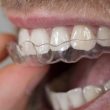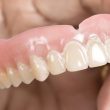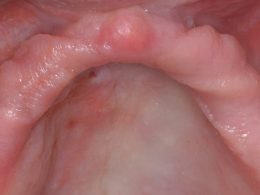Table of Contents
The placement of dental implants is only the first phase of an oral rehabilitation treatment. Implants, by themselves, are useless. At 4, 5 or 6 months after their placement, and osseointegration period ended (bone cicatrization), it is necessary to uncover them surgically to make and fix the definitive prosthesis.
A hybrid prosthesis is one that combines several materials. It is a single fixed structure that is screwed onto 4, 6 or 8 implants (conventional or zygomatic) and that generally replaces all the teeth in an arch. It can be made of metal-porcelain or metal-acrylic, and in cases of maxillary atrophy or severe bone resorption, it incorporates pink artificial gingiva to reestablish the vertical occlusal dimension, lip support, dental aesthetics and facial fullness of the person.
Unlike an overdenture, it is screwed into implants and cannot be removed by the patient. Overdentures are removable, even if they are made on dental implants.
What Are the Advantages of Hybrid Dentures?
Really numerous and varied compared to other restorative alternatives:
- Improve Masticatory Function Unlike a conventional or muco-supported total prosthesis, the hybrid prosthesis can offer up to a 90% increase in chewing efficiency.
- Improve Phonetics and Diction Being fixed, completely stable and much less bulky, they do not interfere with speech or with the articulation of words.
- Improve Aesthetics In addition to replacing teeth, they restore the patient’s vertical dimension and facial fullness. This type of prosthesis not only has a positive impact on the smile, but also on the entire appearance of the face, particularly on its lower third.
- Preservation of Bone Tissue By transmitting functional loads to the bone through dental implants, they prevent the disuse atrophy that always affects the maxillary ridges after tooth extractions.
- They Are Very Long-Lasting They can last for many years with proper hygiene and maintenance.
- Raise Confidence and Self-Esteem Since they allow to talk, eat and chew with total normality. This makes people feel more secure and confident in their daily and social activities.
- Provide Great Comfort They are less bulky than conventional dentures, do not move when speaking or chewing and do not cover the palate; which allows to perceive the flavors with greater intensity.
Compared to full porcelain-based rehabilitations, hybrid metal-acrylic prostheses are lighter, less susceptible to component fracture, quick and easy to repair if necessary, and up to 4 times cheaper than ceramic structures.
What Are Their Disadvantages?
Like all treatments, hybrid prostheses have disadvantages compared to other treatments, such as overdentures for example:
- Unlike an overdenture, hybrid dentures cannot be removed by the patient, requiring more skill and ability to clean them.
- 4-6 implants are needed, unlike the overdenture that can be done with only 2, so its cost is always higher.
When Is a Hybrid Prosthesis the Recommended Treatment?
In totally edentulous patients, that is, in those who have lost all their teeth. Also, in the case that the patient has lost a lot of bone in his jaws.
As we have already mentioned, the main support and retention of a conventional prosthesis is the mucosa and the underlying bone, so that if the patient has them very reabsorbed over the years and the permanent use of muco-supported dentures, the hybrid prosthesis is the better option. Also, it is used in cases where the patient wants a fixed prosthesis but is unable or unwilling to bear the cost of a complete porcelain restoration.
How Is a Hybrid Denture Made?
The first step in its elaboration is to choose the abutments for the implants, followed by an impression of the patient’s mouth to obtain the working model. Then, the Dental Technician Specialized in Implant-Assisted Dentures, makes the design and fabrication in wax of the structure or base of the future prosthesis. Once ready and approved by the Restorative Dentist, the wax pattern is cast to obtain a high-strength alloy metal framework.
Once the structure is ready and fine-tuned, it is mouth-tested to assess its adaptation and passive fit. Next, the artificial acrylic teeth are placed onto the framework, everything is tested again in the mouth and we proceed with the final processing of the acrylic.
Finally, once the prosthesis is ready, it is screwed onto the dental implants.
How Are They Cleaned and Maintained?
Like any prosthetic device, its structural integrity, appearance, and durability; will depend on the care and maintenance that is offered to it. Although this type of prosthesis is quite similar and works in a very similar way to natural teeth, it is essential to make conscious use of it and avoid biting foreign or excessively hard objects such as ice, bones and seeds.
In addition, it is necessary to develop and maintain an adequate oral hygiene routine, within which we recommend always using the following resources:
- Waterpik or Electric Irrigator It is an oral health device designed for home care. It works by means of a jet of water under pressure that passes under the dental prosthesis and removes plaque, food particles and bacteria in an efficient and simple way.
- Superfloss Type Dental Floss It has a rigid part that is inserted under the hybrid prosthesis, to clean its base or internal face (the one that faces the gum or residual ridge). Together with the Waterpik and the interproximal brushes, it is essential to clean under the prosthesis and around the implant abutments.
- Interdental Brushes These brushes have a small head and can be inserted under the prosthesis, and as we said, between the pillars themselves; to eliminate the remains of food retained there.
- Visits to the Dentist Every 6 Months It is recommended that the patient visit his Specialist every 6 months, so that the Dentist can completely remove the denture and perform a thorough cleaning of the abutments and the base or internal face of the prosthesis.
What Other Restorative Alternatives Do Exist?
Patients have several options when it comes to types, materials and restorations supported by dental implants. Let us see the 3 most common, without taking into consideration the hybrid prostheses already described:
- Dental Crowns For those with few missing teeth, dental implants combined with ceramic crowns are a great treatment option. The crowns are custom made for a pinpoint fit and blend almost seamlessly with neighboring teeth. Although in theory, crowns supported by dental implants can be used to replace many or all teeth, the reality is that the high cost of this type of treatment is a frequent limitation. Porcelain-fused to metal crowns and full ceramic crowns are the 2 types of single-unit restorations most indicated.
- Implant-Supported Bridges For those who are missing two or more adjoining teeth but not a full arch, implant-supported fixed bridges are a very popular treatment option. Implant-supported bridges can be used to replace multiple teeth with as few as two or three dental implants, saving money. They are manufactured with the same materials as dental crowns.
- Overdentures It is a total acrylic resin prosthesis, removable and anchored on 2, 3 or 4 implants. It is known as a “lacey denture” because it relies on a male and female system for insertion and removal. The fact that it can be removed by the patient considerably facilitates the oral hygiene process, and although it is removable, the implants provide it great retention and stability compared to a conventional or muco-supported prosthesis.
“The Main Indications of Hybrid Dentures Are Usually the Total Absence of Teeth and the Need to Restore the Person’s Vertical Dimension and Facial Fullness”.
DENTAL TIP
We Are Just One Step Away!
Globalization and dental tourism are two extraordinary tools for accessing world-class Dentistry. Currently millions of people travel to other countries in search of opportunities and prices that allow them to face their dental treatments and recover their smile.
Wherever you are, generally in just a few hours you will be able to get to Venezuela, move to a comfortable hotel and start your oral rehabilitation process with dental implants, porcelain veneers and 100% metal-free ceramic structures; at only a fraction of the cost you would have to pay in your home country.
Almost certainly traveling or not traveling will mean the difference between satisfaction and resignation, or at best; between just getting “something” or be able to reach “the best option”. At DENTAL VIP we are very good hosts and excellent professionals.
Contact us and ascertain how traveling to Venezuela can improve your self-esteem and quality of life!












